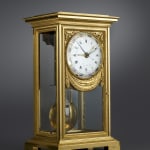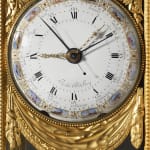Robert Robin French, 1742-1809
Further images
Literature
Winthrop Kellogg Edey, "French Clocks in North American Collections", The Frick Collection exhibition catalogue, November 1982 - January 1983, p. 88-90, illustrating and describing an almost identical but later Robert Robin clock of 1792 probably made for Queen Marie-Antoinette, now in the permanent Frick Collection. Tardy, "Les Plus Belles Pendules Françaises", 1994, p. 136, illustrating a Robin mantle regulator with strike in a similar gilt bronze case. And pp. 139 and 141, illustrating two similar mantle clocks by Robert Robin with polychrome painted dials with signs of the zodiac, housed in slightly different gilt bronze cases. Jean-Dominique Augarde, "Les Ouvriers du Temps", 1996, p. 392, pl. 286, illustrating a similar regulator by Robin of circa 1786-89 with polychrome zodiac dial and equation but housed in a mahogany case and signed aux Galeries du Louvre. Derek Roberts, "Precision Pendulum Clocks, France, Germany, America and Recent Advancements", 2004, p. 32-33, pl. 26-7A-C, illustrating a similar Robin mantle regulator circa 1778 signed Robin à Paris on the Coteau dial and bob with a painted enamel plaque. And pp. 33- 36, pls. 26-8A-J, illustrating another similar but smaller and less sumptuous Robin mantle regulator with case attributed to Pierre-Philippe Thomire, signed Robin Hger de Monsieur on the much plainer dial and signed and dated Robin aux Galeries du Louvre Paris 1788 on the backplate.
A rare and highly important gilt bronze Louis XVI mantel regulator of month duration, the complex movement with equation of time, annual calendar, astrological signs, strike, a fully compensated pendulum and remontoire by the royal clockmaker Robert Robin, the exquisite polychrome dial by Joseph Coteau and case attributed to the pre-eminent fondeur-ciseleur Pierre-Philippe Thomire. The dial signed Robin Hger du Roy and similarly so on the backplate and also Coteau on the dial below 6 o'clock, bearing later inscriptions on the movement: SDLX juin 1822/ Gerard Boilard à Paris Octobre 1974. The beautiful painted white enamel dial with Roman and Arabic numerals for the hours and minutes, a calendar ring with the names of months and their relevant days 10/20/28, 30 or 31, with a beautiful outer ring with painted images of the twelve signs of the zodiac within oval gilt beaded lozenges interspersed by jewelled and foliate scrolls, with an extremely beautiful pair of pierced gilt brass hands for the solar hour and minute indications, the hour hand with a sunburst and arrow pointer, the minute hand with a cut-off fleur-de-lis pointer, a blued steel arrow headed pointer for the mean time and plain blued steel pointers for the calendar indications and for the sweep centre seconds.
The superb movement with equation of time, with remontoire re-wound via Robin's pulley system mounted onto the backplate applying a constant force to the Graham dead-beat escapement, the long crutch arm with fine adjustment for the beat, slotting on to the magnificent and massive free-swinging nine-rod fully compensated pendulum composed of four rectangular brass rods and alternate five polished steel rods being gradually splayed toward the top, with a massive brass bob with fine adjustment terminating with a steel beat pointer, the pendulum with knife edge suspension secured by screws onto a brass plate set into the rear of the case and an L-shaped brass bracket secured to the brass plate and clock case by steel screws, allowing the pendulum suspended from the top of the bracket to swing free from the movement, striking on the solar hour and half hour on a single bell and inscribed on the dial plate Remonté à gauche above 12 o'clock and Remonté/ à gauche below the two winding holes situated on the dial plate below 7 and 5 o'clock.
The wonderful gilt bronze plinth case attributed to Pierre-Philippe Thomire of rectangular form, glazed on all sides with a stepped top, the channelled frame ornamented with stiff leaf borders, cast within the glazed front door with a beaded dial bezel, foliate scrolled spandrels to the upper corners and hung below with a drapery swag
Paris, dated circa 1785
Height 42.8 cm, width 23.7 cm, depth 19 cm.
ROBERT ROBIN (1742-1809), FRENCH
Surprisingly little is known about the early life of Robert Robin, one of the leading French horologists. The first record of his career dates from 1767, the year in which he became a master clockmaker. He [hen set up his own workshop in the Faubourg St.Honore, Paris. Robin was appointed court clockmaker during the later part of Louis XV's reign but was more fully employed by Louis XVT and then by the Republic. In 1785 Robin acquired lodgings in the Galeries du Louvre (where he continued to live until his death}, from here he was at the King's disposal. He became Louis XVl's favourite clockmaker. creating some fine clocks for the royal palaces including a skeleton clock and a fine geographical mantel clock for the Louvre. He also constructed a mantel clock for Marie Antoinette as well as a superb turret clock for the Palm's de Trianon; another mantel clock was made for the Palais de Fontainebleau. Like many of the great French clockmakers, Robin also supplied the aristocracy, particularly before the rise of the French Revolution. Though (he Revolution affected many industries, it did not seriously undermine clock manufacture; and while many court craftsmen were dismissed by the new Republican government, some of them such as Robin were actively encouraged, Robin made a decimal clock as a gift to the National Convention, 1793 and in 1798 convened a 'Louis XIV clock into a 'Clock of Liberty'.
During the Eighteenth Century clock cases assumed increasing importance, Robin, like Julien Le Roy (1686-1759) produced some highly decorative clocks, which combined aesthetic grace with mechanical excellence. Many of Robin's most decorative time pieces were in the Louis XVI style, of which his boudoir clock, 1780 is a fine example (illustrated, F.B. Britten, Old Clocks and Watches and their Maters, 1911, fig. 539). In keeping with the style, it has a while polished marble case, with gilt handles and ornamental mountings, in particular two entwined birds above the face. Robin also introduced more apparent classical motifs, notably gill bronze putti (sometimes adorning Lepaute clocks) and a classical urn surrounding one of his clocks in the Wallace Collection, London. The clock face remains simple with typical Breguet hands, pierced at the tips with a 'moon'. Symbolism also played a part: one of his clocks in a gilt bronze case, c.1780 (Waddesdon Manor, England) is decorated with emblems of the continents. While his calendar clock (pan of the Hamilton Collection, sold in 1882) has a chased ormolu case with allegorical figures of Sculpture and Architecture. Toward the end of his oeuvre Robin devised a stylised decoration to a number of his gilded table regulators; these were presented in a simple and classical case, with little decoration except gilt swags below the dial.
Robin was not only a line exponent of the decorative clock but was also a superb technician, whose innovations were significant to the development of horology. He frequently presented his ideas to the Académie Royale des Sciences and published several scientific papers. Robin time pieces can be found in many notable collections. In addition to those already mentioned there are some fine long case clocks by him in the Victoria and Albert Museum, London. The Guildhall, London owns one of his watches, while a decimal watch of 1794 is housed at the Conservatoire des Arts et Metiers, Paris.
JOSEPH COTEAU (1740-1812). FRENCH
Painted enamel and porcelain dials became increasingly popular during the reign of Louis XVI, reaching perfection in the hands of Joseph Coteau and Gobin Etienne (known as Dubuisson). Coteau was born in Geneva, Switzerland but is known to have practised his specialised craft in Paris. During his maturity he was established at Rue Toupee in the parish of Sant-Andre-des-Arts, where he remained until his death. At the age of 23 he produced the dial for a musical clock by Daille, horologer to Madame la Dauphine, 1763(Wallace Collection, London). Coteau attained such repute that he only ever supplied to the most eminent horologists, including Antide Janvier (1751-1835), Robert Robin (1742-1809) and Ferdinand Berthoud (1727-1807). He is also known to have decorated pieces of jewellery.
Coteau clock dials have a characteristic style, due as much to their superior quality as to their subject. His most distinct decoration consisted of delicate numerals with small garlands of flowers but more usually with signs of the zodiac, each element worked as an individual miniature. Other dials had little or no extra ornament except for the classical Louis XVI style numerals, such as his dial for the Avignon Clock, 1771 (Wallace Collection, London), with the movement by Delunesy and elaborate gilt bronze case sculptured by Louis-Simon Boizot (1743-1809) and executed by Pierre Gouthiere (1732-C.1812). At other times Coteau supplied decorative bands to accompany clock cases, such as an enamel frieze around a vase adorning one of Robert Robin's elaborate clocks, c.1780 (Wallace Collection, London). The band, painted in grisaille, depicts the seasons personified by infants playing and is interspersed by four cameo heads. A similar clock was supplied to Marie Antoinette for Chateau St. Cloud. Decorative dials and their accompanying complex quality movements fell in demand during the Revolution, however Coteau was patronised by the new government to create a number of Republican ten hour dials.
It appears that Coteau never enamelled watches or small scale pieces but specialised in larger works, which were technically more complex due to shrinkage during firing. The techniques required a high degree of skill to achieve a perfect finish. Coteau experimented with various polychromes, producing a blue that was so rare and complex that few if any of his contemporaries managed to copy. The enamel paint was applied with a brush onto a copper plate and the various colours vitrified one by one in a muffle kiln. The decoration was then enhanced by delicate gilding, which after firing resulted in a matt finish, the gilding was finally burnished to restore its metallic brightness.
Coteau dials are extremly rare, they are sometimes "secretly" inscribed on the reverse, in either pen or bruch. In addition to their scarcity and their supreme quality, his dials and enamel plaques only accompanied the most complex quality mechanisms. For these reasons his work is a tru prize and significantly enhances the value of any clock. Examples of his work can be found in a number of European museums, including Mobilier National, Musee des Arts Decoratifs, Paris; Carnavelet Museum, Dijon Museum, and in London at the Wallace Collection and Victoria and Albert Museum.
Copyright by Richard Redding , Zurich, all rights reserved.







